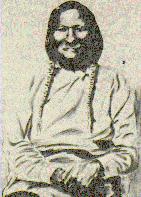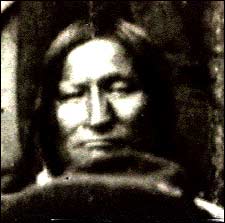|
|
|
|
Cheyenne
Indigenous people of North America whose language belongs to the Algonquian branch of the Algonquian-Wakashan linguistic stock. The Cheyenne abandoned their settlements in Minnesota in the 17th cent., leaving the region to the hostile Sioux and Ojibwa. Gradually migrating W along the Cheyenne River and then south, they established earth-lodge villages and raised crops. After the introduction of the horse (c.1760) they eventually became nomadic buffalo hunters. The tribe split (c.1830) when a large group decided to settle on the upper Arkansas River and take advantage of the trade facilities offered by Bent's Fort. This group became known as the Southern Cheyenne. The Northern Cheyenne continued to live about the headwaters of the Platte River. For the next few years the Southern Cheyenne, allied with the Arapaho, were engaged in constant warfare against the Kiowa, Comanche, and Apache. Peace was made c.1840, and the five tribes became allies. The Cheyenne were generally friendly toward white settlers, until the discovery of gold in Colorado (1858) brought a swarm of gold seekers into their lands. By a treaty signed in 1861 the Cheyenne agreed to live on a reservation in SE Coorado, but the U.S. government did not fulfill its obligations, and the Native Americans were reduced to near starvation. Cheyenne raids resulted in punitive expeditions by the U.S. army. The indiscriminate massacre (1864) of warriors, women, and children at Sand Creek, Colo., was an unprovoked assault on a friendly group. The incident aroused the Native Americans to fury, and a bitter war followed. Gen. George Custer destroyed (1868) Black Kettle's camp on the Washita River, and fighting between the whites and the Southern Cheyenne ended, except for an outbreak in 1874-75. The Northern Cheyenne joined with the Sioux in massacring Custer and his 7th Cavalry at the Battle of the Little Bighorn in 1876. They finally surrendered in 1877 and were moved south and confined with the Southern Cheyenne in what is now Oklahoma. Plagued by disease and malnutrition, they made two desperate attempts to escape and return to the north. A separate reservation was eventually established for them in Montana. See G. B. Grinnell, The Fighting Cheyennes (1915, repr. 1956) and The Cheyenne Indians (2 vol., 1923, repr. 1972); E. A. Hoebel, The Cheyennes (1960); D. J. Berthrong, The Southern Cheyennes (1963); Joseph Millard, The Cheyenne Wars (1964); John Stands in Timber and Margot Liberty, Cheyenne Memories (1967); P. J. Powell, Sweet Medicine (2 vol., 1969); John H. Moore, The Cheyenne Nation (1987).
Chief Black Kettle
 Few biographical details are known about the Southern Few biographical details are known about the Southern
Cheyenne chief Black Kettle, but his repeated efforts to secure a
peace with honor for his people, despite broken promises and
attacks on his own life, speak of him as a great leader with an
almost unique vision of the possiibility for coexistence between
white society and the culture of the plains.
Black Kettle lived on the vast territory in western Kansas and
eastern Colorado that had been guaranteed to the Cheyenne
under the Fort Laramie Treaty of 1851. Within less than a
decade, however, the 1859 Pikes Peak gold rush sparked an
enormous population boom in Colorado, and this led to
extensive white encroachments on Cheyenne land. Even the U.S.
Indian Commissioner admitted that "We have substantially
taken possession of the country and deprived the Indians of
their accustomed means of support."
Rather than evict white settlers, the government sought to
resolve the situation by demanding that the Southern Cheyenne
sign a new treaty ceding all their lands save the small Sand
Creek reservation in southeastern Colorado. Black Kettle,
fearing that overwhelming U.S. military power might result in
an even less favorable settlement, agreed to the treaty in 1861
and did what he could to see that the Cheyenne obeyed its
provisions.
As it turned out, however, the Sand Creek reservation could
not sustain the Indians forced to live there. All but unfit for
agriculture, the barren tract of land was little more than a
breeding ground for epidemic diseases which soon swept
through the Cheyenne encampments. By 1862 the nearest herd
of buffalo was over two hundred miles away. Many Cheyenne,
especially young men, began to leave the reservation to prey
upon the livestock and goods of nearby settlers and passing
wagon trains. One such raid in the spring of 1864 so angered
white Coloradans that they dispatched their militia, which
opened fire on the first band of Cheyenne they happened to
meet. None of the Indians in this band had participated in the
raid, however, and their leader was actually approaching the
militia for a parlay when the shooting began.
This incident touched off an uncoordinated Indian uprising
across the Great Plains, as Indian peoples from the Comanche
in the South to the Lakota in the North took advantage of the
army's involvement in the Civil War by striking back at those
who had encroached upon their lands. Black Kettle, however,
understood white military supremacy too well to support the
cause of war. He spoke with the local military commander at
Fort Weld in Colorado and believed he had secured a promise
of safety in exchange for leading his band back to the Sand
Creek reservation.
But Colonel John Chivington, leader of the Third Colorado
Volunteers, had no intention of honoring such a promise. His
troops had been unsuccessful in finding a Cheyenne band to
fight, so when he learned that Black Kettle had returned to
Sand Creek, he attacked the unsuspecting encampment at dawn
on November 29, 1864. Some two hundred Cheyenne died in
the ensuing massacre, many of them women and children, and
after the slaughter, Chivington's men sexually mutilated and
scalped many of the dead, later exhibiting their trophies to
cheering crowds in Denver.
Black Kettle miraculously escaped harm at the Sand Creek
Massacre, even when he returned to rescue his seriously injured
wife. And perhaps more miraculously, he continued to counsel
peace when the Cheyenne attempted to strike back with isolated
raids on wagon trains and nearby ranches. By October 1865, he
and other Indian leaders had arranged an uneasy truce on the
plains, signing a new treaty that exchanged the Sand Creek
reservation for reservations in southwestern Kansas but
deprived the Cheyenne of access to most of their coveted
Kansas hunting grounds.
Only a part of the Southern Cheyenne nation followed Black
Kettle and the others to these new reservations. Some instead
headed north to join the Northern Cheyenne in Lakota
territory. Many simply ignored the treaty and continued to
range over their ancestral lands. This latter group, consisting
mainly of young warriors allied with a Cheyenne war chief
named Roman Nose, angered the government by their refusal to
obey a treaty they had not signed, and General William
Tecumseh Sherman launched a campaign to force them onto
their assigned lands. Roman Nose and his followers struck back
furiously, and the resulting standoff halted all traffic across
western Kansas for a time.
At this point, government negotiators sought to move the
Cheyenne once again, this time onto two smaller reservations in
Indian Territory (present-day Oklahoma) where they would
receive annual provisions of food and supplies. Black Kettle
was again among the chiefs who signed this treaty, the Medicine
Lodge Treaty of 1867, but after his people had settled on their
new reservation, they did not receive the provisions they had
been promised, and by year's end, more and more of them were
driven to join Roman Nose and his band.
In August 1868, Roman Nose led a series of raids on Kansas
farms that provoked another full-scale military response. Under
General Philip Sheridan, three columns of troops converged to
launch a winter campaign against Cheyenne encampments, with
the Seventh Cavalry commanded by George Armstrong Custer
selected to take the lead. Setting out in a snowstorm, Custer
followed the tracks of a small raiding party to a Cheyenne
village on the Washita River, where he ordered an attack at
dawn.
It was Black Kettle's village, well within the boundaries of the
Cheyenne reservation and with a white flag flying above the
chief's own tipi. Nonetheless, on November 27, 1868, nearly
four years to the day after Sand Creek, Custer's troops charged,
and this time Black Kettle could not escape: "Both the chief
and his wife fell at the river bank riddled with bullets," one
witness reported, "the soldiers rode right over Black Kettle and
his wife and their horse as they lay dead on the ground, and
their bodies were all splashed with mud by the charging
soldiers." Custer later reported that an Osage guide took Black
Kettle's scalp.
On the Washita, the Cheyenne's hopes of sustaining themselves
as an independent people died as well; by 1869, they had been
driven from the plains and confined to reservations.

Cheyenne Literature
Don't stop with the Cheyenne story links. Further down the page is a historyof who the Cheyenne were and where they are today.
http://www.indians.org/welker/cheyenne.htm
Cheyenne-Arapaho Drum
Need a picture to put the finishing touches to your report? This is a good one. It's a colourful front and back view of a Native drum.
http://www.indart.com/gallery/drum2.htm
McKinley Elementary School
check out this good little essay about the Cheyenne nation by a third grader.
http://www.kusd.edu/schools/mckinleyel/107/annar.html
Natchat Mailing List
From where did the Cheyenne come and how did they get their name? Eric Spotted Elk will tell you here. Plain text.
http://bioc09.uthscsa.edu/natnet/archive/nc/9604/0190.html
Treaty with Northern Cheyenne 1868
As the name says, this is the treaty ratified by the government of the United States under Andrew Jackson with the Northern Cheyenne and Northern Arapaho.
http://lbha.netgate.net/chey68.htm
Washita
You can read a disturbing essay about a U.S. army attack on Black Kettle's Cheyenne tribe at Sand Creek. Was it a massacre or a battle? This is followed by an online book-in-progress dealing with the settlement of the west and its impact on Natives in general.
http://www.dickshovel.com/was.html
Cheyenne - http://www.geocities.com/bigorrin/chey.htm
Background information and indexed links about Cheyenne culture, community, history, language, and genealogy.
Cheyenne Genealogy Research - http://www.mcn.net/~hmscook/roots/cheyenne.html
The data set covers over two hundred years of Cheyenne genealogy.
Cheyenne Lands - http://rebelcherokee.tripod.com/cheyenne.html
Historical overview of the Northern and Southern Cheyenne.
Eagle Wing - http://members.nbci.com/eaglewing/
History and culture of the Northern Cheyenne from a tribal member.
Northern Cheyenne Net - http://www.ncheyenne.net/
Tribally owned Internet Service Provider for the Northern Cheyenne Nation.
Northern Cheyenne Tribal Council - http://www.ncheyenne.net/nclegislative3/index.html
Contact information, representatives roster, and meeting schedule.
Tse-tsehese-staestse Literature - http://www.indians.org/welker/cheyenne.htm
Links to Cheyenne stories and other sites of general tribal interest.
Cheyenne Language - http://www.mcn.net/~wleman/cheyenne.htm
Alphabet, pronunciation guide, news and links.
Cheyenne Language - http://www.mcn.net/~wleman/cheypgs.htm
Historical and linguistic portrait of this Algonquian language. Spelling conventions, vocabulary, grammar, literature, and font download.
Cheyenne Language (Tsitsistas) - http://www.geocities.com/bigorrin/chey.htm
Page dedicated to the Cheyenne (Tsitsistas) language, also with information and links about Cheyenne culture, history, and genealogy.
Cheyenne-English Online Dictionary - http://hammer.prohosting.com/~cheydic/
Word by word search.
|
|
|
|
|
|
 Native American Nations
Native American Nations
